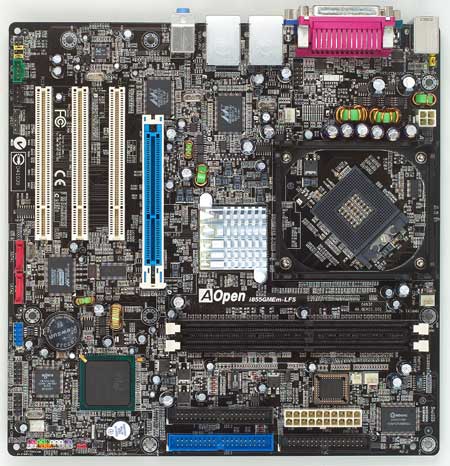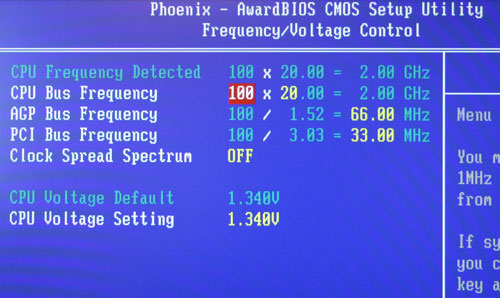Intel's Pentium M on the Desktop - A Viable Alternative?
by Anand Lal Shimpi on February 7, 2005 4:00 PM EST- Posted in
- CPUs
The Motherboards
As we mentioned before, both AOpen and DFI are currently shipping Pentium M desktop micro ATX motherboards based on Intel's 855GME chipset.AOpen
The AOpen GMEm-LFS is a micro ATX board based on the 855GME chipset, with integrated graphics support as provided by the chipset.
AOpen outfitted the board with dual GigE ports, both of which are placed on the back I/O panel above the four USB 2.0 ports.
The board only requires a 20-pin ATX power connector and a 4-pin +12V auxiliary connector like older Pentium 4 motherboards, although you can use a newer 24-pin PSU if you'd like.
Since AOpen uses ICH4-M, only parallel ATA is supported, so AOpen outfitted the board with a Promise SATA RAID controller to drive the two SATA ports on the board. AOpen also placed an Agere FireWire 400 controller on the board; however, they didn't supply the bracket to actually take advantage of the two ports supported by the controller.
The BIOS setup of the GMEm-LFS is pretty straightforward, although we definitely appreciated the layout of the overclocking options. The only complaint we had was that memory dividers weren't explicitly listed, which requires some math on the user's part to make sure that they're selecting the right memory speed when overclocking. The only voltage adjustments present on the board are for Vcore, which unfortunately tops out at 1.340V.

We had pretty decent overclocking success with the AOpen board and our Pentium M 755 (2.0GHz). Running it at 133MHz (533MHz FSB) x 18 at the maximum core voltage of 1.340V proved to be quite stable in all of our benchmarks. We could get the Pentium M to POST at 2.53GHz, but it wasn't stable enough to run our benchmarks.
Unfortunately, the biggest problem with overclocking the AOpen (as well as the DFI) board was that you could hardly overclock the memory bus. Regardless of what type of DDR400 memory we used, the highest that we could get the memory bus to run (stable) was 355MHz using the 4:3 memory divider.
Given how bandwidth-starved the Pentium M is, we were hoping for better overclocking success in the memory department, but were met with disappointment. The problem appears to be related to the 855GME chipset, as the DFI board suffered the same fate as the AOpen board.
So, while there's headroom in the CPUs (even our 1.7GHz Pentium Ms had no problems running above 2.0GHz), it seems like the chipsets/motherboards will limit the extent to which you can overclock.
The AOpen GMEm-LFS currently sells for $230.










77 Comments
View All Comments
fitten - Tuesday, February 8, 2005 - link
Also, it's interesting that there are many benchmarks chosen which are known to stress the weaknesses of the Pentium-M... not that it isn't interesting information. For example, there seems to be a whole lot of FPU intensive benchmarks (around 15 or so, all of which the Pentium-M should lose handily - known before they are even run) so kind of just hammering the point home I guess.Anyway, the Dothans held up pretty well from what I can see... Most of the time (except for the notable FPU intensive and memory bandwidth intensive benchmarks), the Dothan compares quite well with Athlon64s of the same clock speed that have the advantage of dual channel memory.
fitten - Tuesday, February 8, 2005 - link
The other interesting thing about the Athlon64 vs. Dothan comparison is that even with dual channel memory bandwidth on the Athlon64's side, the single channel memory bandwidth of the Dothan still keeps it very close in many of the benchmarks and can even beat the dual channel Athlon64s at 400MHz higher clock in some.Anyway, the Pentium-M family is a good start. Some tweaking here and there (improved FPU with better FPU performance and maybe another FPU execution unit, improved memory subsystem to make good use of dual channel) and it will be at least as good as the Athlon64s across the board.
I own three Athlon64 desktops, two AthlonXP desktops, and two Pentium-M laptops and the laptops are by no means "slow" at doing work.
KristopherKubicki - Tuesday, February 8, 2005 - link
teutonicknight: We purposely don't change our test platform too often. Even though we are using a slightly older version of Premiere, it is the same version we have used in our other processor analyses.Hope that helps,
Kristopher
kmmatney - Tuesday, February 8, 2005 - link
There's also a Celeron version that would have been intersting to review. The small L2 cache should hurt the performance, though. I think the celeron version using something like 7 Watts. It would make no sense to put a celeron-M in such an expensive motherboard, though.Slaimus - Tuesday, February 8, 2005 - link
I think this indirectly shows how AMD needs to update its caching architecture on the K8. They basically carried over the K7 caches, which is just too slow when paired with its memory controller. Instead of being as large as possible (as evidenced by the exclusive caches) at the expense of latency, the K8 needs faster caches. The memory bandwith of L2 vs system memory is only about 2 to 1 on the K8, which is to say the L2 cache is not helping the system memory much.sandorski - Monday, February 7, 2005 - link
I think the Pentium M mythos can now be laid to rest.mjz5 - Monday, February 7, 2005 - link
to #29:your 2800 is the 754 pin.
the 3000+ reviewed is the 939 pin which is 1.8. the 3000+ for the 754 is 2.0 ghz
kristof007 - Monday, February 7, 2005 - link
I don't know if anyone else noticed but the charts are a bit off. My A64 2800+ is running at a stock 1.8 ghz .. while in the review the A64 3000+ is running at 1.8 ... weird!knitecrow - Monday, February 7, 2005 - link
#251) Intel and AMD measure TDP differently... and TDP is not the same as actual power dissipation. The actual dissipation of 90nm A64 is pretty darn good.
2) A microprocessor is not made of Lego... you can't rearrange/tweak parts to make it faster. It takes a lot of time, energy and talent to make changes -- even then it may not work for the best. Prescott anyone?
Frankly I’ve been waiting for a good review of P-M's actual performance. I really don't trust those "other" sites.
k00kie - Monday, February 7, 2005 - link